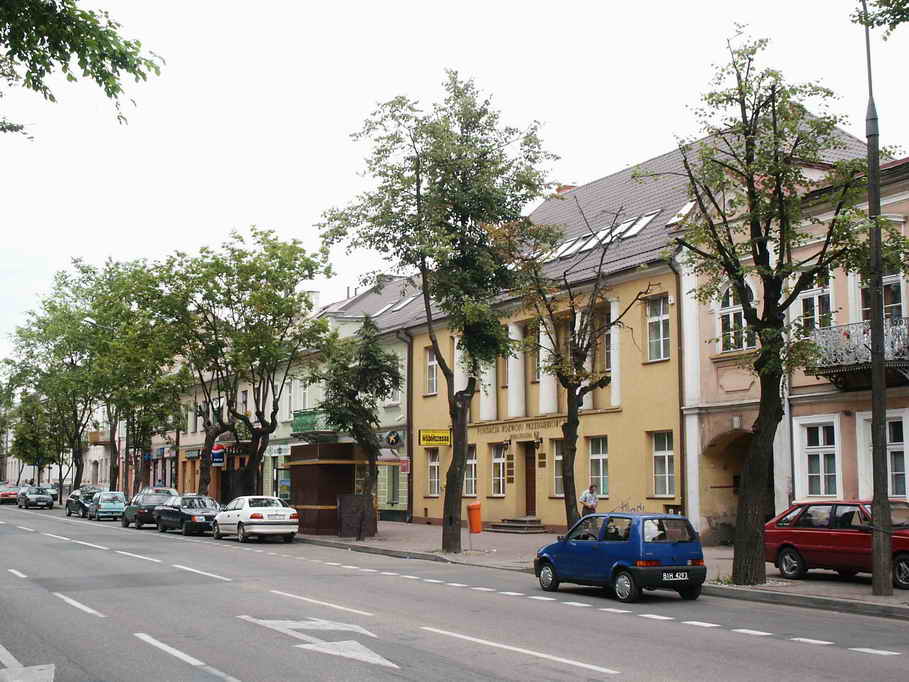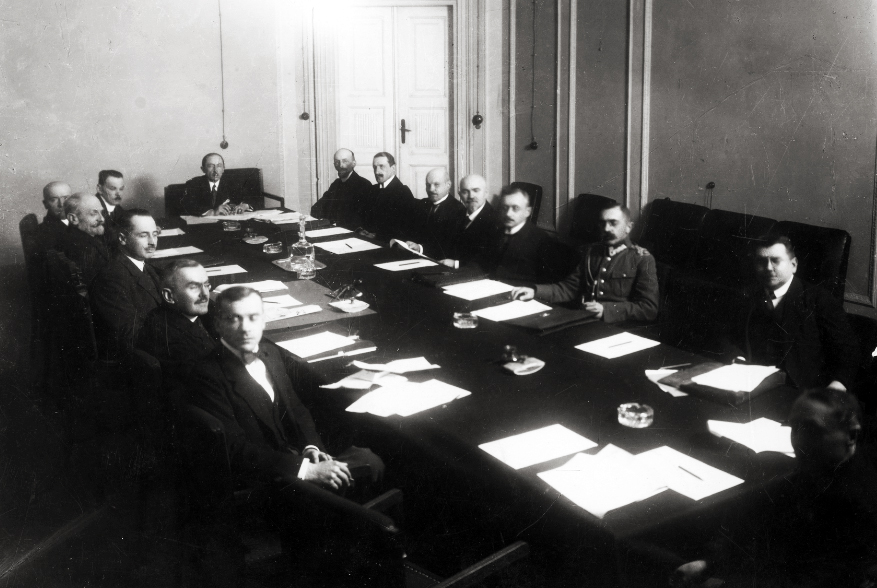|
Edward Szczepanik
Edward Franciszek Szczepanik (; 22 August 1915 – 11 October 2005) was a Poles, Polish economist and the last Prime Minister of the Republic of Poland, Prime Minister of the Polish Government in Exile. Biography Szczepanik was born on 21 August 1915 (his birth was registered with the birth date of 22 August 1915) in Suwałki, a small town in northern Poland, while the country was part of Imperial Russia under Imperial Germany, German occupation. Early life Edward lived in Kościuszko street, he went to the local grammar school and then studied at the Warsaw School of Economics (SGH). He studied for his MSc in political economy under Professor Edward Lipiński (economist), Edward Lipiński in 1936. During his compulsory military service he was stationed at the Artillery Officers' School with the 29th Light Artillery Regiment. He won a scholarship to study at the London School of Economics, studying under Professors Lionel Robbins, Friedrich Hayek and Paul Narcyz Rosenste ... [...More Info...] [...Related Items...] OR: [Wikipedia] [Google] [Baidu] |
Prime Minister Of Poland
The President of the Council of Ministers ( pl, Prezes Rady Ministrów, lit=Chairman of the Council of Ministers), colloquially referred to as the prime minister (), is the head of the cabinet and the head of government of Poland. The responsibilities and traditions of the office stem from the creation of the contemporary Polish state, and the office is defined in the Constitution of 1997. According to the Constitution, the president nominates and appoints the prime minister, who will then propose the composition of the Cabinet. Fourteen days following their appointment, the prime minister must submit a programme outlining the government's agenda to the Sejm, requiring a vote of confidence.Article 154, para. 2 Conflicts stemming from both interest and powers have arisen between the offices of President and Prime Minister in the past. The incumbent and seventeenth prime minister is Mateusz Morawiecki of the Law and Justice party. Morawiecki replaced Prime Minister Beata Szydło, ... [...More Info...] [...Related Items...] OR: [Wikipedia] [Google] [Baidu] |
Lionel Robbins
Lionel Charles Robbins, Baron Robbins, (22 November 1898 – 15 May 1984) was a British economist, and prominent member of the economics department at the London School of Economics (LSE). He is known for his leadership at LSE, his proposed definition of economics, and for his instrumental efforts in shifting Anglo-Saxon economies, Anglo-Saxon economics from its Alfred Marshall, Marshallian direction. He is famous for the quote, "Humans want what they can't have." Early life Robbins was born in Sipson, west of London, the son of Rowland Richard Robbins (1872–1960), known as Dick, and his wife Rosa Marion Harris; his father was a farmer, a member of Middlesex County Council involved also in the National Farmers' Union of England and Wales, National Farmers' Union, and the family was Strict Baptist. His sister Caroline Robbins, Caroline became a noted Professor of History at Bryn Mawr College. Robbins was educated at home, at Hounslow College (a Preparatory school (United Kingd ... [...More Info...] [...Related Items...] OR: [Wikipedia] [Google] [Baidu] |
Battle Of Monte Cassino
The Battle of Monte Cassino, also known as the Battle for Rome and the Battle for Cassino, was a series of four assaults made by the Allies against German forces in Italy during the Italian Campaign of World War II. The ultimate objective was to break through the Winter Line, and facilitate an advance towards Rome. At the beginning of 1944, the western half of the Winter Line was anchored by Germans holding the Rapido-Gari, Liri and Garigliano valleys and several of the surrounding peaks and ridges. Together, these features formed the Gustav Line. Monte Cassino, a historic hilltop abbey founded in 529 by the Benedict of Nursia, dominated the nearby town of Cassino and the entrances to the Liri and Rapido valleys. Lying in a protected historic zone, it had been left unoccupied by the Germans, although they manned some positions set into the slopes below the abbey's walls. Repeated artillery attacks on assaulting allied troops caused their leaders to conclude incorrectly that ... [...More Info...] [...Related Items...] OR: [Wikipedia] [Google] [Baidu] |
Władysław Anders
) , birth_name = Władysław Albert Anders , birth_date = , birth_place = Krośniewice-Błonie, Warsaw Governorate, Congress Poland, Russian Empire , death_date = , death_place = London, England, United Kingdom , serviceyears = 1913–1946 , unit = Polish II Corps , battles = First World War Polish–Bolshevik WarSecond World War * Invasion of Poland ** Battle of Tomaszów Lubelski ** Battle of Wladypol * Italian Campaign ** Monte Cassino ** Battle of Ancona ** Battle of Bologna , awards = '' See list below'' , spouse = , relations = , laterwork = Władysław Albert Anders (11 August 1892 – 12 May 1970) was a general in the Polish Army and later in life a politician and prominent member of the Polish government-in-exile in London. Biography Before World War II Anders was born on 11 August 1892 to his father Albert Anders and mother Elizabeth (maiden name Tauchert) in the village of Krośniewice–Błonie, ... [...More Info...] [...Related Items...] OR: [Wikipedia] [Google] [Baidu] |
Polish II Corps
The Polish II Corps ( pl, Drugi Korpus Wojska Polskiego), 1943–1947, was a major tactical and operational unit of the Polish Armed Forces in the West during World War II. It was commanded by Lieutenant General Władysław Anders and fought with distinction in the Italian Campaign, in particular at the Battle of Monte Cassino. By the end of 1945, the corps had grown to well over 100,000 soldiers. History Victims of Soviet deportations from occupied Poland in 1939–40 had been processed by the NKVD and sent to prison or exile in Siberia. The Nazi-Soviet pact of August 1939 effectively ended on 22 June 1941 when the German Wehrmacht invaded the USSR. The release of many thousands of former citizens of Poland (including Ukrainians and Belorussians) from the Soviet Gulags, following the signing of the Polish-Russian Military Agreement on 14 August 1941, allowed for the creation of a Polish Army on Soviet soil. Its first commander, General Michał Tokarzewski, began the task of f ... [...More Info...] [...Related Items...] OR: [Wikipedia] [Google] [Baidu] |
Operation Barbarossa
Operation Barbarossa (german: link=no, Unternehmen Barbarossa; ) was the invasion of the Soviet Union by Nazi Germany and many of its Axis allies, starting on Sunday, 22 June 1941, during the Second World War. The operation, code-named after Frederick Barbarossa ("red beard"), a 12th-century Holy Roman emperor and German king, put into action Nazi Germany's ideological goal of conquering the western Soviet Union to repopulate it with Germans. The German aimed to use some of the conquered people as forced labour for the Axis war effort while acquiring the oil reserves of the Caucasus as well as the agricultural resources of various Soviet territories. Their ultimate goal was to create more (living space) for Germany, and the eventual extermination of the indigenous Slavic peoples by mass deportation to Siberia, Germanisation, enslavement, and genocide. In the two years leading up to the invasion, Nazi Germany and the Soviet Union signed political and economic pacts for st ... [...More Info...] [...Related Items...] OR: [Wikipedia] [Google] [Baidu] |
Kola Peninsula
sjd, Куэлнэгк нёа̄ррк , image_name= Kola peninsula.png , image_caption= Kola Peninsula as a part of Murmansk Oblast , image_size= 300px , image_alt= , map_image= Murmansk in Russia.svg , map_caption = Location of Murmansk Oblast within Russia , location= Northwest Russia , coordinates= , area_km2= 100000 , length_km= 370 , width_km= 244 , highest_mount= Yudychvumchorr , elevation_m= 1201 , waterbody = * Barents Sea * White Sea , country= Russia , country_admin_divisions_title= Oblast , country_admin_divisions= Murmansk Oblast , density_km2= , demonym= , population= , citizenships= The Kola Peninsula (russian: Кольский полуостров, Kolsky poluostrov; sjd, Куэлнэгк нёа̄ррк) is a peninsula in the extreme northwest of Russia, and one of the largest peninsulas of Europe. Constituting the bulk of the territory of Murmansk Oblast, it lies almost completely inside the Arctic Circle and is bordered by the Barents Sea to the n ... [...More Info...] [...Related Items...] OR: [Wikipedia] [Google] [Baidu] |
Kozielsk
:''"Kozielsk" is also the Polish name for the Russian town of Kozelsk.'' Kozielsk is a village in the administrative district of Gmina Kuczbork-Osada, within Żuromin County, Masovian Voivodeship, in north-central Poland. It lies approximately east of Kuczbork-Osada, east of Żuromin, and north-west of Warsaw Warsaw ( pl, Warszawa, ), officially the Capital City of Warsaw,, abbreviation: ''m.st. Warszawa'' is the capital and largest city of Poland. The metropolis stands on the River Vistula in east-central Poland, and its population is officia .... References Villages in Żuromin County {{Żuromin-geo-stub ... [...More Info...] [...Related Items...] OR: [Wikipedia] [Google] [Baidu] |
Gulag
The Gulag, an acronym for , , "chief administration of the camps". The original name given to the system of camps controlled by the GPU was the Main Administration of Corrective Labor Camps (, )., name=, group= was the government agency in charge of the Soviet network of forced labour camps which were set up by order of Vladimir Lenin, reaching its peak during Joseph Stalin's rule from the 1930s to the early 1950s. English-language speakers also use the word ''gulag'' in reference to each of the forced-labor camps that existed in the Soviet Union, including the camps that existed in the post-Lenin era. The Gulag is recognized as a major instrument of political repression in the Soviet Union. The camps housed a wide range of convicts, from petty criminals to political prisoners, a large number of whom were convicted by simplified procedures, such as NKVD troikas or other instruments of extrajudicial punishment. In 1918–22, the agency was administered by the Cheka, follow ... [...More Info...] [...Related Items...] OR: [Wikipedia] [Google] [Baidu] |
Lithuania
Lithuania (; lt, Lietuva ), officially the Republic of Lithuania ( lt, Lietuvos Respublika, links=no ), is a country in the Baltic region of Europe. It is one of three Baltic states and lies on the eastern shore of the Baltic Sea. Lithuania shares land borders with Latvia to the north, Belarus to the east and south, Poland to the south, and Russia to the southwest. It has a Maritime boundary, maritime border with Sweden to the west on the Baltic Sea. Lithuania covers an area of , with a population of 2.8 million. Its capital and largest city is Vilnius; other major cities are Kaunas and Klaipėda. Lithuanians belong to the ethno-linguistic group of the Balts and speak Lithuanian language, Lithuanian, one of only a few living Baltic languages. For millennia the southeastern shores of the Baltic Sea were inhabited by various Balts, Baltic tribes. In the 1230s, Lithuanian lands were united by Mindaugas, Monarchy of Lithuania, becoming king and founding the Kingdom of Lithuania ... [...More Info...] [...Related Items...] OR: [Wikipedia] [Google] [Baidu] |
Invasion Of Poland (1939)
The invasion of Poland (1 September – 6 October 1939) was a joint attack on the Republic of Poland by Nazi Germany and the Soviet Union which marked the beginning of World War II. The German invasion began on 1 September 1939, one week after the signing of the Molotov–Ribbentrop Pact between Germany and the Soviet Union, and one day after the Supreme Soviet of the Soviet Union had approved the pact. The Soviets invaded Poland on 17 September. The campaign ended on 6 October with Germany and the Soviet Union dividing and annexing the whole of Poland under the terms of the German–Soviet Frontier Treaty. The invasion is also known in Poland as the September campaign ( pl, kampania wrześniowa) or 1939 defensive war ( pl, wojna obronna 1939 roku, links=no) and known in Germany as the Poland campaign (german: Überfall auf Polen, Polenfeldzug). German forces invaded Poland from the north, south, and west the morning after the Gleiwitz incident. Slovak military forces adv ... [...More Info...] [...Related Items...] OR: [Wikipedia] [Google] [Baidu] |





.jpg)

